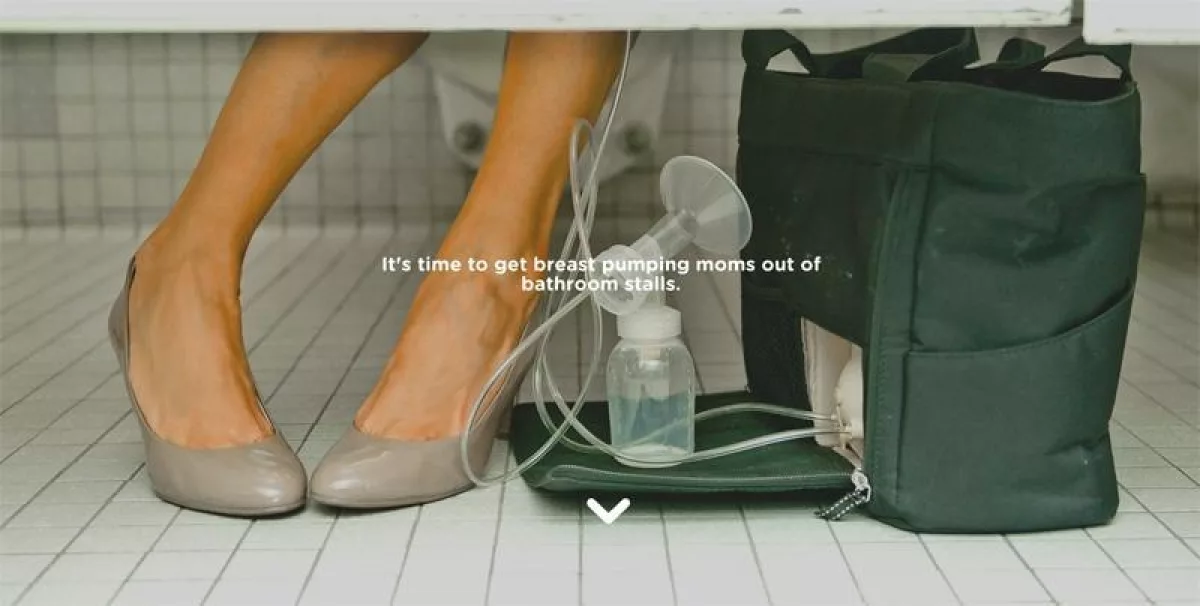Maternal Breast as Machine of Nutrition, by Olivia Labb
30 May 2016
Olivia Labb is an Honours student at AUT Spatial Design School of Art & Design, working on solutions to the provision of space for women to breastfeed their children when away from the home. This essay is an extract from her project, being run in a joint association between AUT and the Auckland Hospital.

MATERNAL BREAST AS MACHINE OF NUTRITION
Olivia Labb
History
+
Media
= Mass Culture
The act of eating is not usually perceived of as an overtly sexual act. However in the case of breastfeeding for the nurturing of a young child, there has since the late 19th century in western culture been a slow shift of attitude that sees in the feeding breast a gesture that is too sexual, immodest, awkward and is therefore something that is not welcome in the public domain. Anti-breast-exposure for the purpose of child nutrition arouse in the context of the streamlining and mechanization of the human body in the late 19th and early 20th century (Berney, 2001). With the rise of what Michel Foucault recognised as a disciplinary society. The industrialization of labour practices resulted in a partitioning of workers from home, and an increasing division of space according to gender. Public space or spaces beyond the home increasingly assumed a homosocial (Homosocial (definition): relating to social relations between one gender) characteristic – a sociality proper to male hegemony (Foucault, 1995)(Hegemony (definition): relating to dominance). Adrienne Berney, who writes about maternal practices in relation to social transformations in America and Europe (Also refer to Hausman for further discussion of Adrienne Berney’s contribution to the study of maternal relations in North America and Europe. (Hausman, 2003, p.196), has argued that in western culture before 1890 the lactating female breast was seen as a comforting, nourishing, maternal pacifier for ‘clinging nurslings’ (2001, p.330). Yet subsequently this image of the nurturing, maternal breast was transformed into a controllable, manipulable, engine for nourishment (Berney, 2001). This shift in corporeal understanding, a shift encompassing a resignification of the maternal breast from being naturally nurturing to being an organ for effective delivery of nutrients, was achieved in large part through advertising material and mass media. As Jackson Lears, a contemporary American cultural historian has argued: “advertising imagery acted as a catalyst in this transformation… [with] the rise of corporate advertising redefined the ‘iconography of abundance’ from the fecund earth to the efficient factory” (cited in Berney, 2001, p.330). Furthermore the circulation and availability of this kind of material became surprisingly standard across all areas of society. As Berney herself puts it,
The ideas these sources convey were accessible primarily to middle-class and elite women in the period 1880-1940. Increasingly, however, the American working class of the twentieth century also has access to the literacy and disposable income necessary to consume this kind of mass culture. Moreover, while physicians interacted with women of means in private practices, public health programmes distributed standard medical knowledge among the masses. (Berney, 2001, p.328)
Of particular interest is the views of a physician of the period, Moses T.Runnells, who wrote in Physical degeneracy of American women that:
There can be no doubt whatever that the true and essential function of these glands at the present day is ornamental and aesthetic. Their noblest opportunities are not in the “Milky way”, but in the line of high art and realistic delineation. (Cited in Berney, 2001, p.331)
As machine and in particular automobile culture influenced ideals of the female body, design historian Jeffery Meikle explains that, “stylish women of the 1930’s ‘sought a sleek modern look to match their automobiles” (Cited in Berney, 2001, p.338). This ideal of women’s bodies being firm, slender and youthful, particularly the breast, made them amenable to eroticization in mass culture (Berney, 2001, p.336).
As more western women find themselves living their daily lives outside the privacy of the domestic interior, there is need for a society that better supports and accepts public breastfeeding as everyday collective experience. Foucault’s recognition of spaces beyond the home assuming progressively male homosocial characteristics, is increasingly out of touch with our more modern workplace and public experience. In the New Zealand work force alone, 64.0% of women are in paid employment, while men at 74.4%, are only 10.4% more represented. (Statistics New Zealand, 2016). The statistics indicate that the more gender-balanced labour markets should demand work and public environments that are more heterosocial.
Lactation suites
+
public space
= enforcing status quo
A recent spatial/product solution responding to the issue of breastfeeding in public, and expressing on the go, is the ‘Mamava freestanding lactation suite’ in North America. Founders of Mamava Incorporated and the freestanding lactation suite, Christine Dodsen and Sascha Mayer, graphic designers by trade, developed this product out of personal and social desire to get working and travelling mothers who need to express and breastfeed out of bathrooms. This facility is designed with a particular focus for expressing women due to the undressing, and therefore privacy often required. However my research is more interested in the influence of these facilities on public attitudes towards public breastfeeding. (Therefore I am not questioning the value of these facilities for expressing and mothers who wish to breastfeeding privately. ) The Mamava lactation suite has been successfully implemented in numerous airports, stadiums and hospitals across America.
This example is a poignant precedence where the needs of a lactating mother have been identified, designed for and implemented into a public space in a positive and celebratory manner. However it is only one solution, and I believe there is a long way to keep going in the area of normalising space in public provided for breastfeeding mothers. As the Mamava website states:
Mamava… provides privacy, cleanliness, and all you need to use a breast pump or nurse an infant — while simultaneously reminding passersby that breastfeeding should be supported and celebrated by all of us because of the good it does for babies, women, families, and society in general… We have never wanted to hide breastfeeding — our goal is to do just the opposite by raising the profile of this natural human function, and celebrating the realities of the logistics involved in taking on breastfeeding. (Mamava Inc, 2016)
The discourse accompanying the Mamava lactation suite and its business model, while aiming for a certain private dignity for breastfeeding women, achieves its celebration and works well in busy public areas. A question remains - is this at the expense of normalised visibility? As such, it possibly leaves unchallenged a broader acceptance of the visible presence of sexed bodies in the public realm. In short the feeding breast continues to be privatised and put out of sight, while sexualised breasts are common throughout media. As scholarship on feminist design, science and technology studies has shown, "artefacts (or actants) both act on the world around them and shape socio-spatial practice” (Boyer, 2012, p.558). It could be claimed that while lactation suites like this one achieve a visibility for breastfeeding in the public domain as intended, they may also help maintain the status quo of public spaces as homosocial of male hegemony.
A baby will demand to be fed in the middle of the street, supermarket or park, possibly miles away from a lactation facility. If as a society we demand equality for all, we must also consider what equality means to a baby. As adults we may consume sustenance in just about any public or private sphere, the office, on the street, on public transport and so forth. (Although ritual and social rules around eating in public are also wide and complex - not addressed in this article.) Surely this should be the same for a baby, regardless of the means by which the baby receives this sustenance. Great steps forward have been taken and it is hoped that more follow. Design has a crucial role in such social, political and cultural shifts, the difficulty is in the separation of the perceived sexual body from the feeding body in the public domain.

Reference List:
Berney, A. (2001). Streamlining breasts: the exaltation of form and disguise of function in 1930s’ ideals. Journal of Design History, 14(4), 327-342.
Boyer, K. (2012). Affect, corporeality and the limits of belonging: Breastfeeding in public in the contemporary UK. Health and Place, 18(3), 552-560.
Dictionary. (2016) Aversive. Retrived from http://www.dictionary.com/browse/aversive
Foucault, M. (1995). Discipline and Punish the Birth of the Prison (A. Sheridan, Trans.). New York, United States of America: Random House. Retrieved from https://zulfahmed.files.wordpress.com/2013/12/disciplineandpunish.pdf
Hausman, B.L. (2003). Mothers Milk: Breastfeeding controversies in American culture. New York: Routledge. Retrieved from http://www.amazon.com/Mothers-Milk-Breastfeeding-Controversies-American/dp/0415966574
New Zealand Statistics. (2016). More women in the labour force, fewer stay-at-home parents than 1986. Retrieved from http://www.stats.govt.nz/browse_for_stats/income-and-work/employment_and_unemployment/30-years-hlfs-mr.aspx
Figure List:
Figure 1: Project Logo.
Project Logo, photoshop document, 2016, Olivia Labb
Figure 2: Figure 2: Mamava Lactation Suite in Airport, USA.
Mamava Inc. (2016). Design Solutions for nursing mothers on the go. Retrieved from http://www.mamava.com/
Figure 3: Getting nursing women out of bathroom stalls
Mamava Inc. (2016). It’s time to get breast pumping moms out of bathroom stalls. Retrieved from http://www.mamava.com/lactivate/












